Operations and Service Management: A Case Study of Tesla
VerifiedAdded on 2023/06/11
|9
|2934
|377
AI Summary
This report discusses the operations management practices of Tesla, including quality management, technology incorporation, and support services. It also analyzes how these practices affect the efficiency of the organization.
Contribute Materials
Your contribution can guide someone’s learning journey. Share your
documents today.
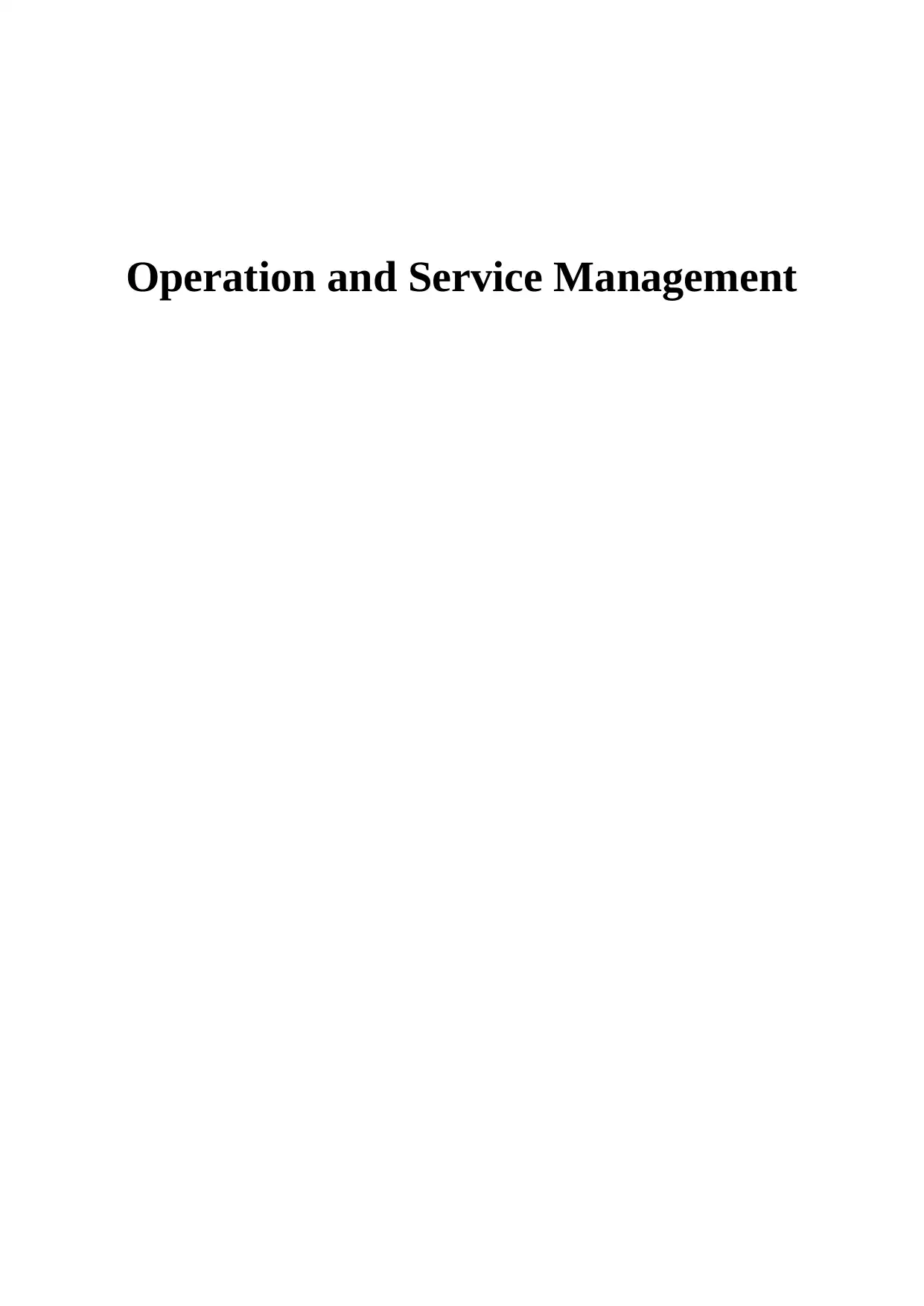
Operation and Service Management
Secure Best Marks with AI Grader
Need help grading? Try our AI Grader for instant feedback on your assignments.
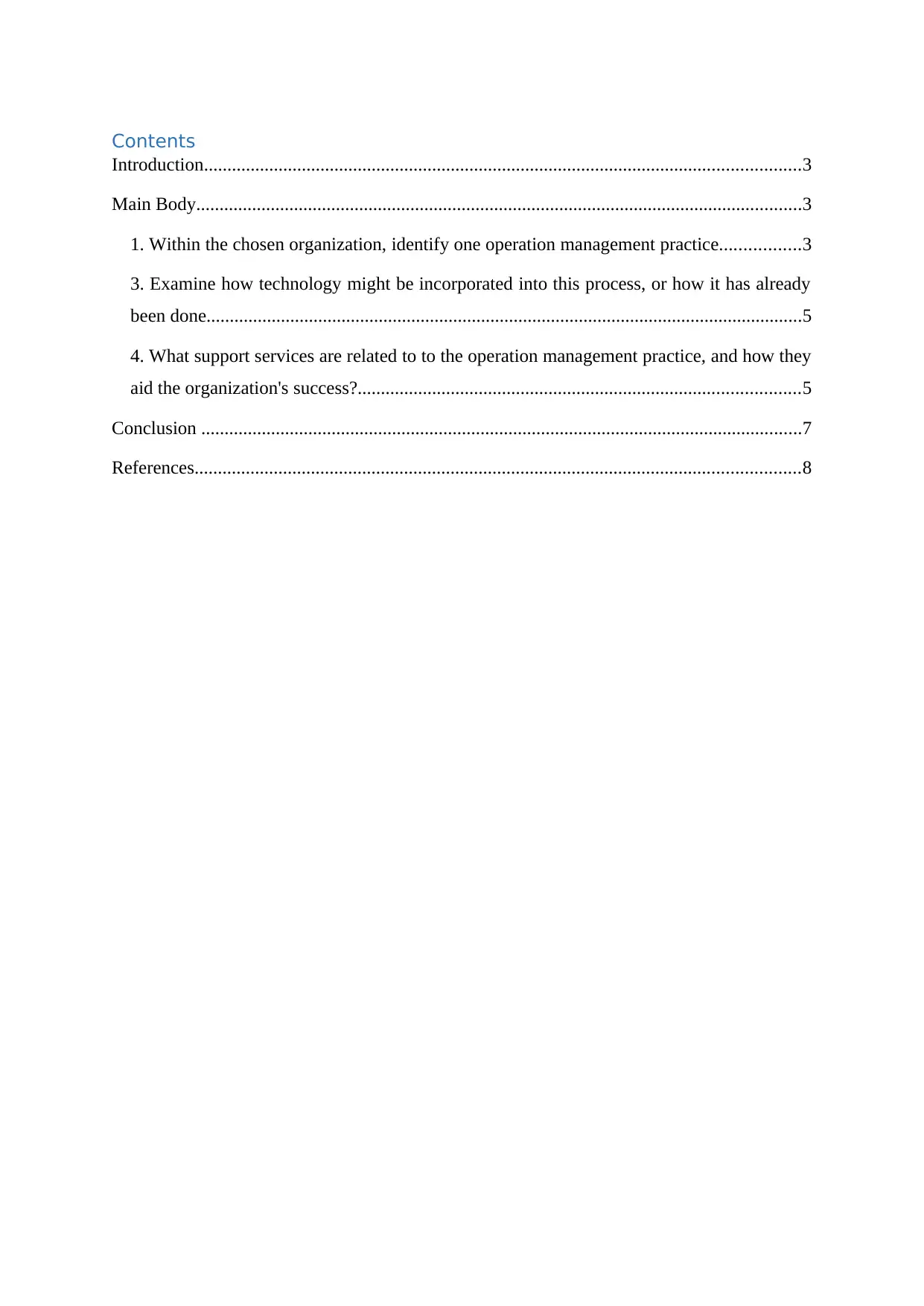
Contents
Introduction................................................................................................................................3
Main Body..................................................................................................................................3
1. Within the chosen organization, identify one operation management practice.................3
3. Examine how technology might be incorporated into this process, or how it has already
been done................................................................................................................................5
4. What support services are related to to the operation management practice, and how they
aid the organization's success?...............................................................................................5
Conclusion .................................................................................................................................7
References..................................................................................................................................8
Introduction................................................................................................................................3
Main Body..................................................................................................................................3
1. Within the chosen organization, identify one operation management practice.................3
3. Examine how technology might be incorporated into this process, or how it has already
been done................................................................................................................................5
4. What support services are related to to the operation management practice, and how they
aid the organization's success?...............................................................................................5
Conclusion .................................................................................................................................7
References..................................................................................................................................8
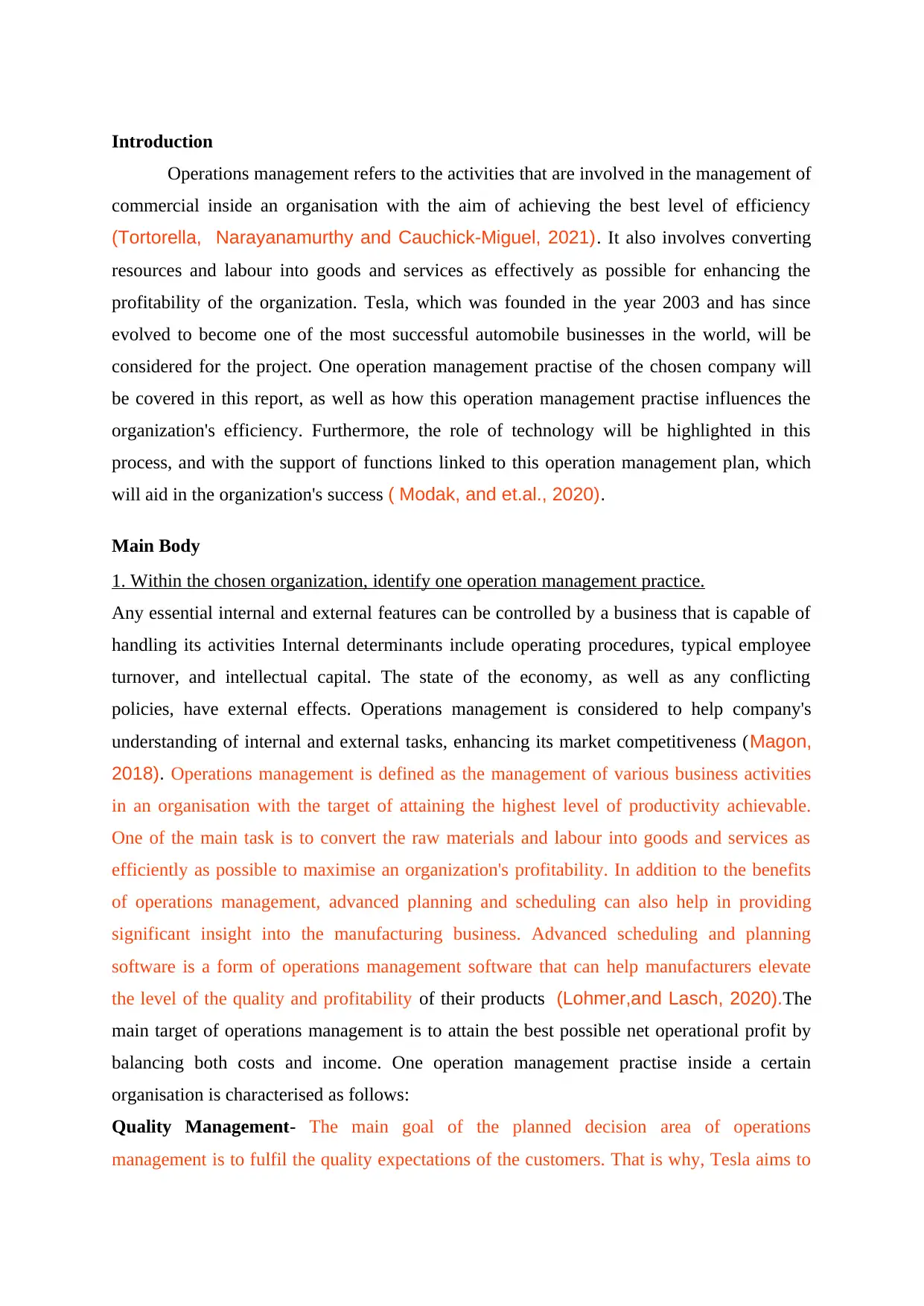
Introduction
Operations management refers to the activities that are involved in the management of
commercial inside an organisation with the aim of achieving the best level of efficiency
(Tortorella, Narayanamurthy and Cauchick-Miguel, 2021). It also involves converting
resources and labour into goods and services as effectively as possible for enhancing the
profitability of the organization. Tesla, which was founded in the year 2003 and has since
evolved to become one of the most successful automobile businesses in the world, will be
considered for the project. One operation management practise of the chosen company will
be covered in this report, as well as how this operation management practise influences the
organization's efficiency. Furthermore, the role of technology will be highlighted in this
process, and with the support of functions linked to this operation management plan, which
will aid in the organization's success ( Modak, and et.al., 2020).
Main Body
1. Within the chosen organization, identify one operation management practice.
Any essential internal and external features can be controlled by a business that is capable of
handling its activities Internal determinants include operating procedures, typical employee
turnover, and intellectual capital. The state of the economy, as well as any conflicting
policies, have external effects. Operations management is considered to help company's
understanding of internal and external tasks, enhancing its market competitiveness (Magon,
2018). Operations management is defined as the management of various business activities
in an organisation with the target of attaining the highest level of productivity achievable.
One of the main task is to convert the raw materials and labour into goods and services as
efficiently as possible to maximise an organization's profitability. In addition to the benefits
of operations management, advanced planning and scheduling can also help in providing
significant insight into the manufacturing business. Advanced scheduling and planning
software is a form of operations management software that can help manufacturers elevate
the level of the quality and profitability of their products (Lohmer,and Lasch, 2020).The
main target of operations management is to attain the best possible net operational profit by
balancing both costs and income. One operation management practise inside a certain
organisation is characterised as follows:
Quality Management- The main goal of the planned decision area of operations
management is to fulfil the quality expectations of the customers. That is why, Tesla aims to
Operations management refers to the activities that are involved in the management of
commercial inside an organisation with the aim of achieving the best level of efficiency
(Tortorella, Narayanamurthy and Cauchick-Miguel, 2021). It also involves converting
resources and labour into goods and services as effectively as possible for enhancing the
profitability of the organization. Tesla, which was founded in the year 2003 and has since
evolved to become one of the most successful automobile businesses in the world, will be
considered for the project. One operation management practise of the chosen company will
be covered in this report, as well as how this operation management practise influences the
organization's efficiency. Furthermore, the role of technology will be highlighted in this
process, and with the support of functions linked to this operation management plan, which
will aid in the organization's success ( Modak, and et.al., 2020).
Main Body
1. Within the chosen organization, identify one operation management practice.
Any essential internal and external features can be controlled by a business that is capable of
handling its activities Internal determinants include operating procedures, typical employee
turnover, and intellectual capital. The state of the economy, as well as any conflicting
policies, have external effects. Operations management is considered to help company's
understanding of internal and external tasks, enhancing its market competitiveness (Magon,
2018). Operations management is defined as the management of various business activities
in an organisation with the target of attaining the highest level of productivity achievable.
One of the main task is to convert the raw materials and labour into goods and services as
efficiently as possible to maximise an organization's profitability. In addition to the benefits
of operations management, advanced planning and scheduling can also help in providing
significant insight into the manufacturing business. Advanced scheduling and planning
software is a form of operations management software that can help manufacturers elevate
the level of the quality and profitability of their products (Lohmer,and Lasch, 2020).The
main target of operations management is to attain the best possible net operational profit by
balancing both costs and income. One operation management practise inside a certain
organisation is characterised as follows:
Quality Management- The main goal of the planned decision area of operations
management is to fulfil the quality expectations of the customers. That is why, Tesla aims to
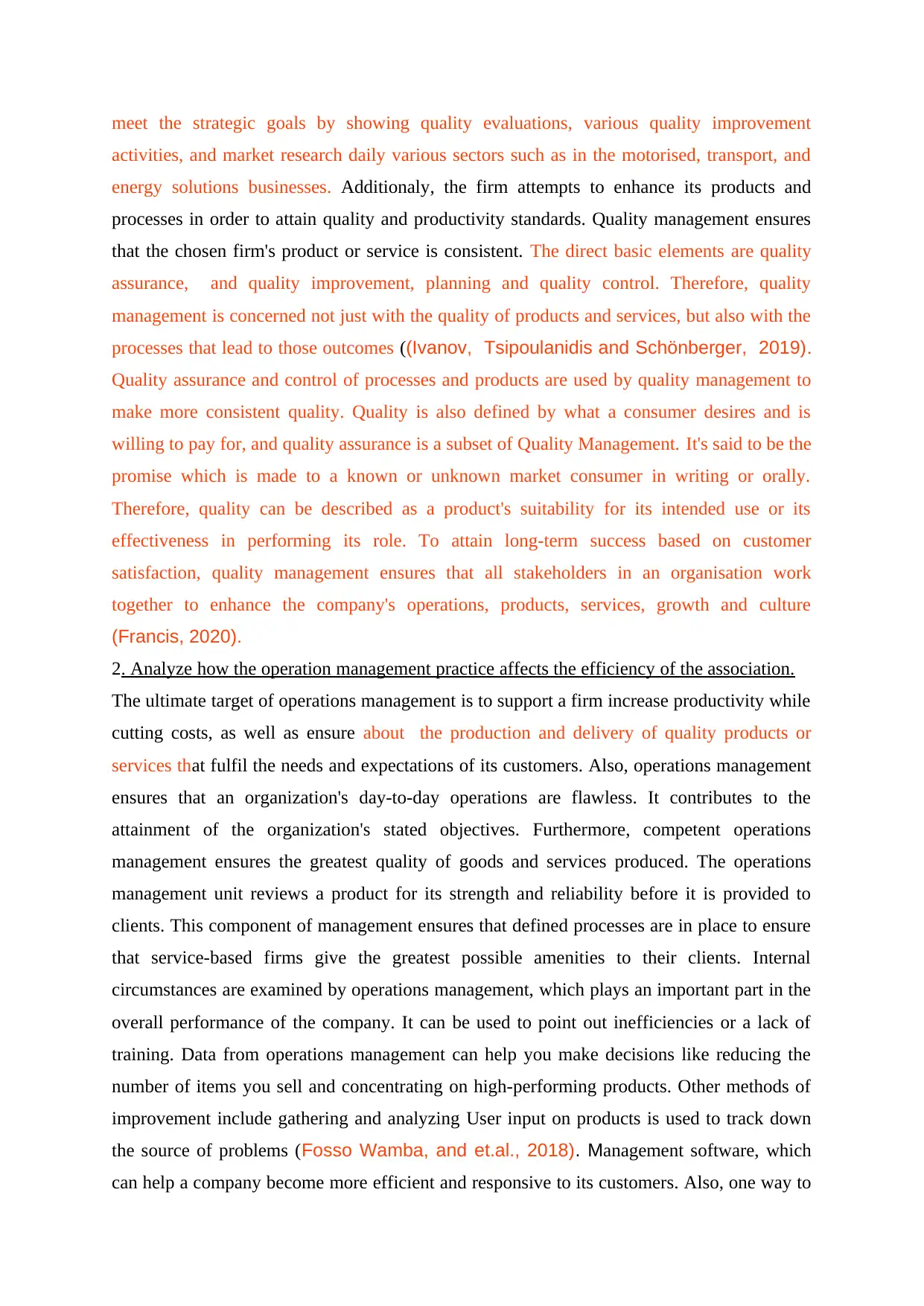
meet the strategic goals by showing quality evaluations, various quality improvement
activities, and market research daily various sectors such as in the motorised, transport, and
energy solutions businesses. Additionaly, the firm attempts to enhance its products and
processes in order to attain quality and productivity standards. Quality management ensures
that the chosen firm's product or service is consistent. The direct basic elements are quality
assurance, and quality improvement, planning and quality control. Therefore, quality
management is concerned not just with the quality of products and services, but also with the
processes that lead to those outcomes ((Ivanov, Tsipoulanidis and Schönberger, 2019).
Quality assurance and control of processes and products are used by quality management to
make more consistent quality. Quality is also defined by what a consumer desires and is
willing to pay for, and quality assurance is a subset of Quality Management. It's said to be the
promise which is made to a known or unknown market consumer in writing or orally.
Therefore, quality can be described as a product's suitability for its intended use or its
effectiveness in performing its role. To attain long-term success based on customer
satisfaction, quality management ensures that all stakeholders in an organisation work
together to enhance the company's operations, products, services, growth and culture
(Francis, 2020).
2. Analyze how the operation management practice affects the efficiency of the association.
The ultimate target of operations management is to support a firm increase productivity while
cutting costs, as well as ensure about the production and delivery of quality products or
services that fulfil the needs and expectations of its customers. Also, operations management
ensures that an organization's day-to-day operations are flawless. It contributes to the
attainment of the organization's stated objectives. Furthermore, competent operations
management ensures the greatest quality of goods and services produced. The operations
management unit reviews a product for its strength and reliability before it is provided to
clients. This component of management ensures that defined processes are in place to ensure
that service-based firms give the greatest possible amenities to their clients. Internal
circumstances are examined by operations management, which plays an important part in the
overall performance of the company. It can be used to point out inefficiencies or a lack of
training. Data from operations management can help you make decisions like reducing the
number of items you sell and concentrating on high-performing products. Other methods of
improvement include gathering and analyzing User input on products is used to track down
the source of problems (Fosso Wamba, and et.al., 2018). Management software, which
can help a company become more efficient and responsive to its customers. Also, one way to
activities, and market research daily various sectors such as in the motorised, transport, and
energy solutions businesses. Additionaly, the firm attempts to enhance its products and
processes in order to attain quality and productivity standards. Quality management ensures
that the chosen firm's product or service is consistent. The direct basic elements are quality
assurance, and quality improvement, planning and quality control. Therefore, quality
management is concerned not just with the quality of products and services, but also with the
processes that lead to those outcomes ((Ivanov, Tsipoulanidis and Schönberger, 2019).
Quality assurance and control of processes and products are used by quality management to
make more consistent quality. Quality is also defined by what a consumer desires and is
willing to pay for, and quality assurance is a subset of Quality Management. It's said to be the
promise which is made to a known or unknown market consumer in writing or orally.
Therefore, quality can be described as a product's suitability for its intended use or its
effectiveness in performing its role. To attain long-term success based on customer
satisfaction, quality management ensures that all stakeholders in an organisation work
together to enhance the company's operations, products, services, growth and culture
(Francis, 2020).
2. Analyze how the operation management practice affects the efficiency of the association.
The ultimate target of operations management is to support a firm increase productivity while
cutting costs, as well as ensure about the production and delivery of quality products or
services that fulfil the needs and expectations of its customers. Also, operations management
ensures that an organization's day-to-day operations are flawless. It contributes to the
attainment of the organization's stated objectives. Furthermore, competent operations
management ensures the greatest quality of goods and services produced. The operations
management unit reviews a product for its strength and reliability before it is provided to
clients. This component of management ensures that defined processes are in place to ensure
that service-based firms give the greatest possible amenities to their clients. Internal
circumstances are examined by operations management, which plays an important part in the
overall performance of the company. It can be used to point out inefficiencies or a lack of
training. Data from operations management can help you make decisions like reducing the
number of items you sell and concentrating on high-performing products. Other methods of
improvement include gathering and analyzing User input on products is used to track down
the source of problems (Fosso Wamba, and et.al., 2018). Management software, which
can help a company become more efficient and responsive to its customers. Also, one way to
Secure Best Marks with AI Grader
Need help grading? Try our AI Grader for instant feedback on your assignments.
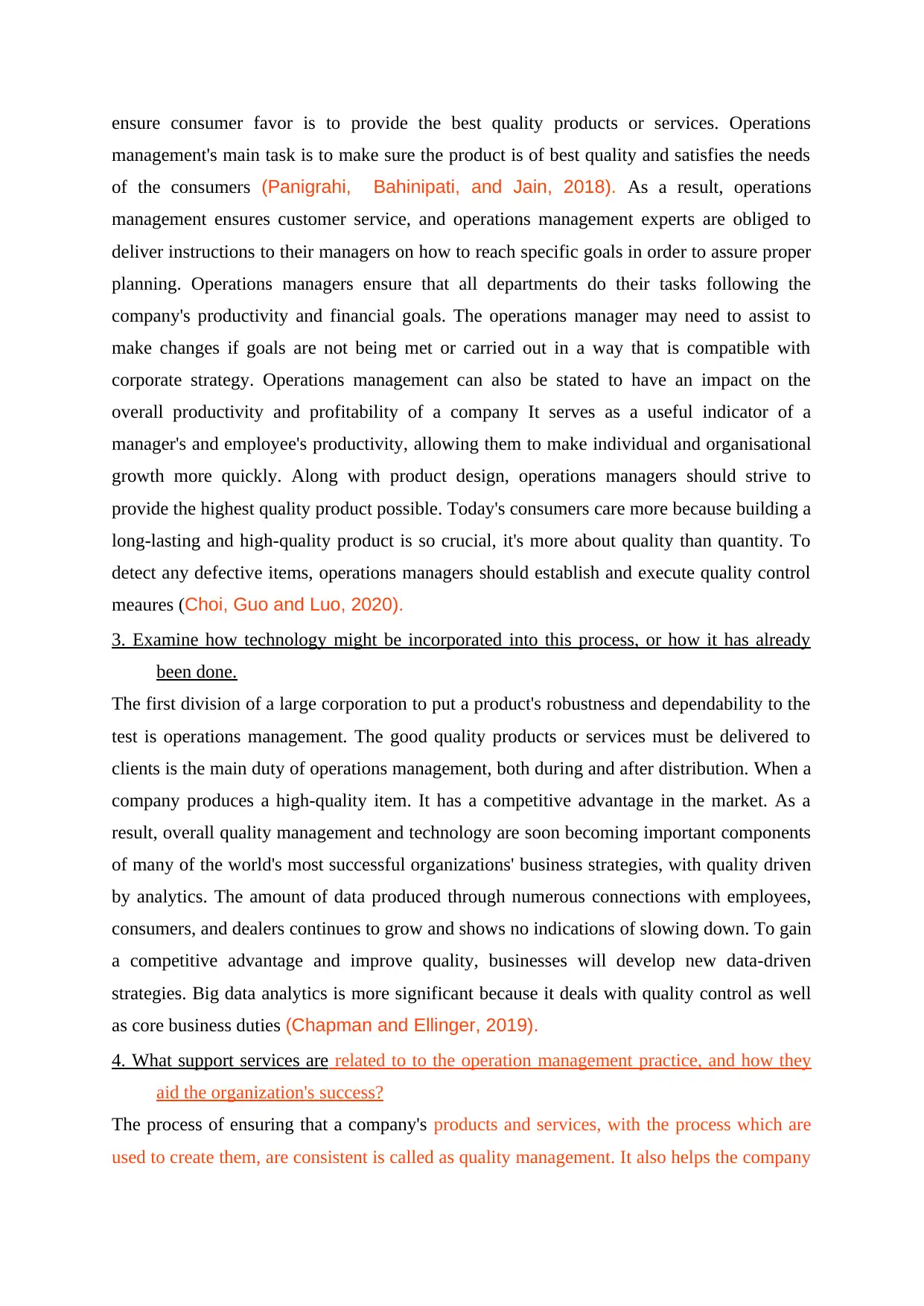
ensure consumer favor is to provide the best quality products or services. Operations
management's main task is to make sure the product is of best quality and satisfies the needs
of the consumers (Panigrahi, Bahinipati, and Jain, 2018). As a result, operations
management ensures customer service, and operations management experts are obliged to
deliver instructions to their managers on how to reach specific goals in order to assure proper
planning. Operations managers ensure that all departments do their tasks following the
company's productivity and financial goals. The operations manager may need to assist to
make changes if goals are not being met or carried out in a way that is compatible with
corporate strategy. Operations management can also be stated to have an impact on the
overall productivity and profitability of a company It serves as a useful indicator of a
manager's and employee's productivity, allowing them to make individual and organisational
growth more quickly. Along with product design, operations managers should strive to
provide the highest quality product possible. Today's consumers care more because building a
long-lasting and high-quality product is so crucial, it's more about quality than quantity. To
detect any defective items, operations managers should establish and execute quality control
meaures (Choi, Guo and Luo, 2020).
3. Examine how technology might be incorporated into this process, or how it has already
been done.
The first division of a large corporation to put a product's robustness and dependability to the
test is operations management. The good quality products or services must be delivered to
clients is the main duty of operations management, both during and after distribution. When a
company produces a high-quality item. It has a competitive advantage in the market. As a
result, overall quality management and technology are soon becoming important components
of many of the world's most successful organizations' business strategies, with quality driven
by analytics. The amount of data produced through numerous connections with employees,
consumers, and dealers continues to grow and shows no indications of slowing down. To gain
a competitive advantage and improve quality, businesses will develop new data-driven
strategies. Big data analytics is more significant because it deals with quality control as well
as core business duties (Chapman and Ellinger, 2019).
4. What support services are related to to the operation management practice, and how they
aid the organization's success?
The process of ensuring that a company's products and services, with the process which are
used to create them, are consistent is called as quality management. It also helps the company
management's main task is to make sure the product is of best quality and satisfies the needs
of the consumers (Panigrahi, Bahinipati, and Jain, 2018). As a result, operations
management ensures customer service, and operations management experts are obliged to
deliver instructions to their managers on how to reach specific goals in order to assure proper
planning. Operations managers ensure that all departments do their tasks following the
company's productivity and financial goals. The operations manager may need to assist to
make changes if goals are not being met or carried out in a way that is compatible with
corporate strategy. Operations management can also be stated to have an impact on the
overall productivity and profitability of a company It serves as a useful indicator of a
manager's and employee's productivity, allowing them to make individual and organisational
growth more quickly. Along with product design, operations managers should strive to
provide the highest quality product possible. Today's consumers care more because building a
long-lasting and high-quality product is so crucial, it's more about quality than quantity. To
detect any defective items, operations managers should establish and execute quality control
meaures (Choi, Guo and Luo, 2020).
3. Examine how technology might be incorporated into this process, or how it has already
been done.
The first division of a large corporation to put a product's robustness and dependability to the
test is operations management. The good quality products or services must be delivered to
clients is the main duty of operations management, both during and after distribution. When a
company produces a high-quality item. It has a competitive advantage in the market. As a
result, overall quality management and technology are soon becoming important components
of many of the world's most successful organizations' business strategies, with quality driven
by analytics. The amount of data produced through numerous connections with employees,
consumers, and dealers continues to grow and shows no indications of slowing down. To gain
a competitive advantage and improve quality, businesses will develop new data-driven
strategies. Big data analytics is more significant because it deals with quality control as well
as core business duties (Chapman and Ellinger, 2019).
4. What support services are related to to the operation management practice, and how they
aid the organization's success?
The process of ensuring that a company's products and services, with the process which are
used to create them, are consistent is called as quality management. It also helps the company
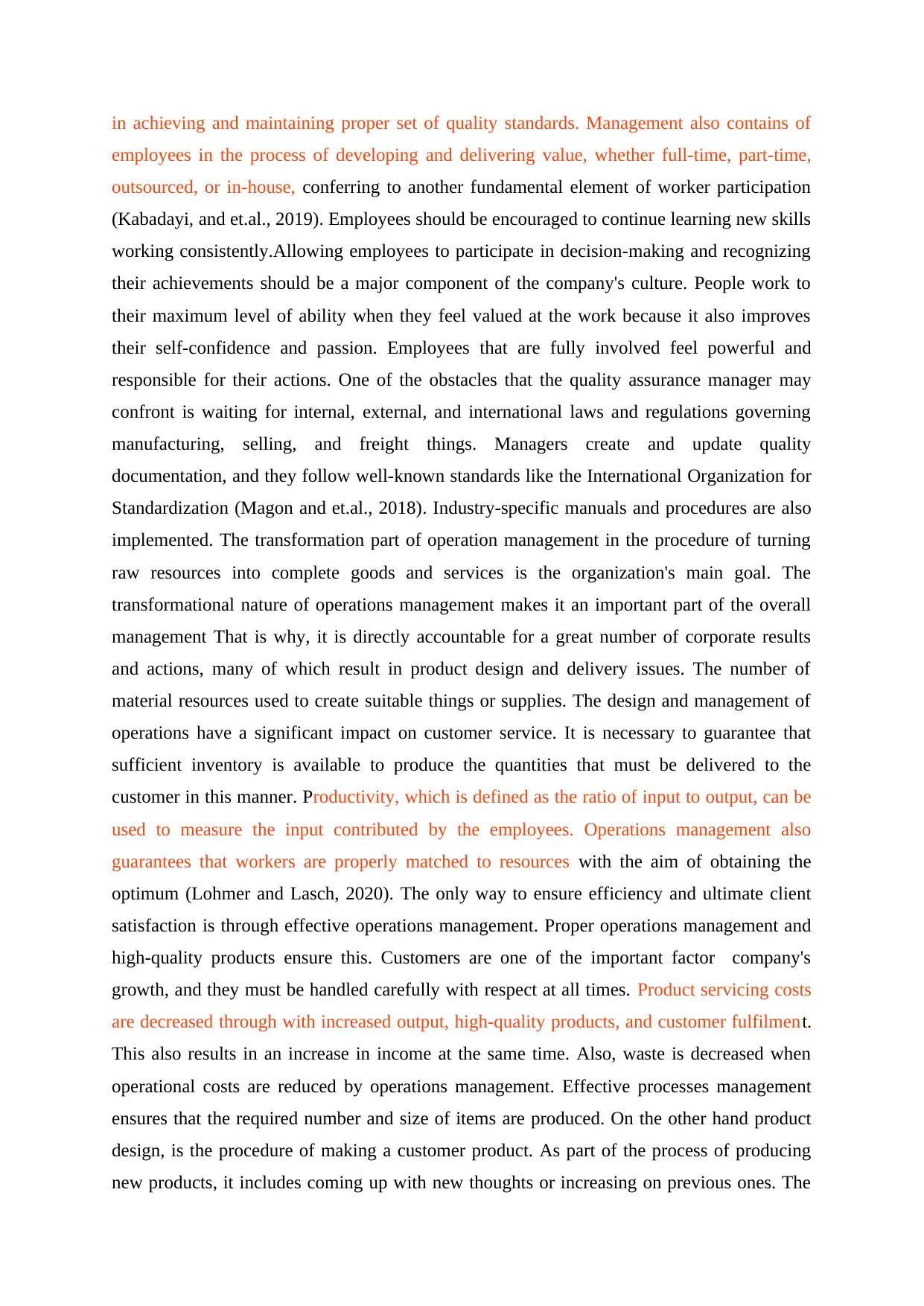
in achieving and maintaining proper set of quality standards. Management also contains of
employees in the process of developing and delivering value, whether full-time, part-time,
outsourced, or in-house, conferring to another fundamental element of worker participation
(Kabadayi, and et.al., 2019). Employees should be encouraged to continue learning new skills
working consistently.Allowing employees to participate in decision-making and recognizing
their achievements should be a major component of the company's culture. People work to
their maximum level of ability when they feel valued at the work because it also improves
their self-confidence and passion. Employees that are fully involved feel powerful and
responsible for their actions. One of the obstacles that the quality assurance manager may
confront is waiting for internal, external, and international laws and regulations governing
manufacturing, selling, and freight things. Managers create and update quality
documentation, and they follow well-known standards like the International Organization for
Standardization (Magon and et.al., 2018). Industry-specific manuals and procedures are also
implemented. The transformation part of operation management in the procedure of turning
raw resources into complete goods and services is the organization's main goal. The
transformational nature of operations management makes it an important part of the overall
management That is why, it is directly accountable for a great number of corporate results
and actions, many of which result in product design and delivery issues. The number of
material resources used to create suitable things or supplies. The design and management of
operations have a significant impact on customer service. It is necessary to guarantee that
sufficient inventory is available to produce the quantities that must be delivered to the
customer in this manner. Productivity, which is defined as the ratio of input to output, can be
used to measure the input contributed by the employees. Operations management also
guarantees that workers are properly matched to resources with the aim of obtaining the
optimum (Lohmer and Lasch, 2020). The only way to ensure efficiency and ultimate client
satisfaction is through effective operations management. Proper operations management and
high-quality products ensure this. Customers are one of the important factor company's
growth, and they must be handled carefully with respect at all times. Product servicing costs
are decreased through with increased output, high-quality products, and customer fulfilment.
This also results in an increase in income at the same time. Also, waste is decreased when
operational costs are reduced by operations management. Effective processes management
ensures that the required number and size of items are produced. On the other hand product
design, is the procedure of making a customer product. As part of the process of producing
new products, it includes coming up with new thoughts or increasing on previous ones. The
employees in the process of developing and delivering value, whether full-time, part-time,
outsourced, or in-house, conferring to another fundamental element of worker participation
(Kabadayi, and et.al., 2019). Employees should be encouraged to continue learning new skills
working consistently.Allowing employees to participate in decision-making and recognizing
their achievements should be a major component of the company's culture. People work to
their maximum level of ability when they feel valued at the work because it also improves
their self-confidence and passion. Employees that are fully involved feel powerful and
responsible for their actions. One of the obstacles that the quality assurance manager may
confront is waiting for internal, external, and international laws and regulations governing
manufacturing, selling, and freight things. Managers create and update quality
documentation, and they follow well-known standards like the International Organization for
Standardization (Magon and et.al., 2018). Industry-specific manuals and procedures are also
implemented. The transformation part of operation management in the procedure of turning
raw resources into complete goods and services is the organization's main goal. The
transformational nature of operations management makes it an important part of the overall
management That is why, it is directly accountable for a great number of corporate results
and actions, many of which result in product design and delivery issues. The number of
material resources used to create suitable things or supplies. The design and management of
operations have a significant impact on customer service. It is necessary to guarantee that
sufficient inventory is available to produce the quantities that must be delivered to the
customer in this manner. Productivity, which is defined as the ratio of input to output, can be
used to measure the input contributed by the employees. Operations management also
guarantees that workers are properly matched to resources with the aim of obtaining the
optimum (Lohmer and Lasch, 2020). The only way to ensure efficiency and ultimate client
satisfaction is through effective operations management. Proper operations management and
high-quality products ensure this. Customers are one of the important factor company's
growth, and they must be handled carefully with respect at all times. Product servicing costs
are decreased through with increased output, high-quality products, and customer fulfilment.
This also results in an increase in income at the same time. Also, waste is decreased when
operational costs are reduced by operations management. Effective processes management
ensures that the required number and size of items are produced. On the other hand product
design, is the procedure of making a customer product. As part of the process of producing
new products, it includes coming up with new thoughts or increasing on previous ones. The
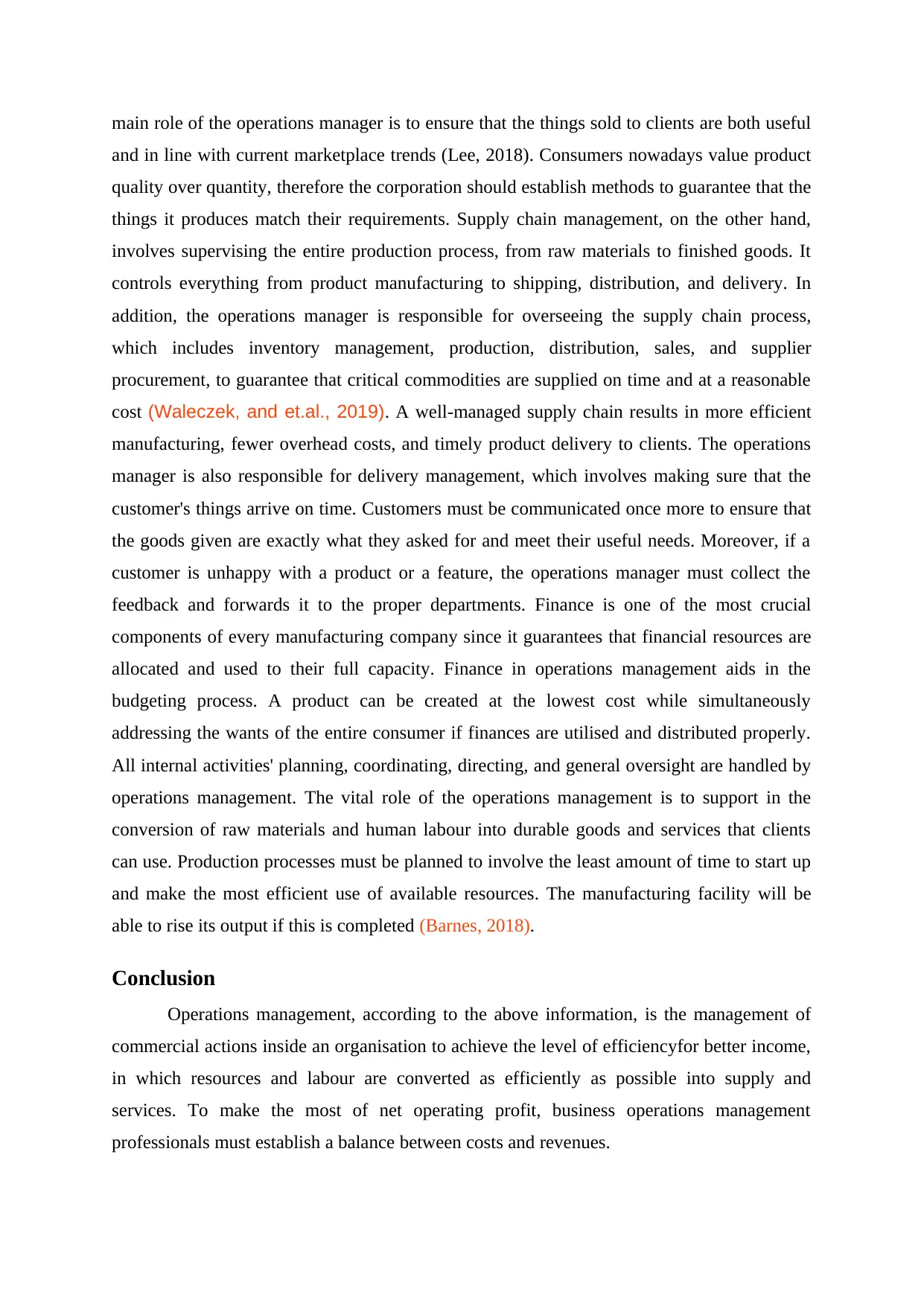
main role of the operations manager is to ensure that the things sold to clients are both useful
and in line with current marketplace trends (Lee, 2018). Consumers nowadays value product
quality over quantity, therefore the corporation should establish methods to guarantee that the
things it produces match their requirements. Supply chain management, on the other hand,
involves supervising the entire production process, from raw materials to finished goods. It
controls everything from product manufacturing to shipping, distribution, and delivery. In
addition, the operations manager is responsible for overseeing the supply chain process,
which includes inventory management, production, distribution, sales, and supplier
procurement, to guarantee that critical commodities are supplied on time and at a reasonable
cost (Waleczek, and et.al., 2019). A well-managed supply chain results in more efficient
manufacturing, fewer overhead costs, and timely product delivery to clients. The operations
manager is also responsible for delivery management, which involves making sure that the
customer's things arrive on time. Customers must be communicated once more to ensure that
the goods given are exactly what they asked for and meet their useful needs. Moreover, if a
customer is unhappy with a product or a feature, the operations manager must collect the
feedback and forwards it to the proper departments. Finance is one of the most crucial
components of every manufacturing company since it guarantees that financial resources are
allocated and used to their full capacity. Finance in operations management aids in the
budgeting process. A product can be created at the lowest cost while simultaneously
addressing the wants of the entire consumer if finances are utilised and distributed properly.
All internal activities' planning, coordinating, directing, and general oversight are handled by
operations management. The vital role of the operations management is to support in the
conversion of raw materials and human labour into durable goods and services that clients
can use. Production processes must be planned to involve the least amount of time to start up
and make the most efficient use of available resources. The manufacturing facility will be
able to rise its output if this is completed (Barnes, 2018).
Conclusion
Operations management, according to the above information, is the management of
commercial actions inside an organisation to achieve the level of efficiencyfor better income,
in which resources and labour are converted as efficiently as possible into supply and
services. To make the most of net operating profit, business operations management
professionals must establish a balance between costs and revenues.
and in line with current marketplace trends (Lee, 2018). Consumers nowadays value product
quality over quantity, therefore the corporation should establish methods to guarantee that the
things it produces match their requirements. Supply chain management, on the other hand,
involves supervising the entire production process, from raw materials to finished goods. It
controls everything from product manufacturing to shipping, distribution, and delivery. In
addition, the operations manager is responsible for overseeing the supply chain process,
which includes inventory management, production, distribution, sales, and supplier
procurement, to guarantee that critical commodities are supplied on time and at a reasonable
cost (Waleczek, and et.al., 2019). A well-managed supply chain results in more efficient
manufacturing, fewer overhead costs, and timely product delivery to clients. The operations
manager is also responsible for delivery management, which involves making sure that the
customer's things arrive on time. Customers must be communicated once more to ensure that
the goods given are exactly what they asked for and meet their useful needs. Moreover, if a
customer is unhappy with a product or a feature, the operations manager must collect the
feedback and forwards it to the proper departments. Finance is one of the most crucial
components of every manufacturing company since it guarantees that financial resources are
allocated and used to their full capacity. Finance in operations management aids in the
budgeting process. A product can be created at the lowest cost while simultaneously
addressing the wants of the entire consumer if finances are utilised and distributed properly.
All internal activities' planning, coordinating, directing, and general oversight are handled by
operations management. The vital role of the operations management is to support in the
conversion of raw materials and human labour into durable goods and services that clients
can use. Production processes must be planned to involve the least amount of time to start up
and make the most efficient use of available resources. The manufacturing facility will be
able to rise its output if this is completed (Barnes, 2018).
Conclusion
Operations management, according to the above information, is the management of
commercial actions inside an organisation to achieve the level of efficiencyfor better income,
in which resources and labour are converted as efficiently as possible into supply and
services. To make the most of net operating profit, business operations management
professionals must establish a balance between costs and revenues.
Paraphrase This Document
Need a fresh take? Get an instant paraphrase of this document with our AI Paraphraser
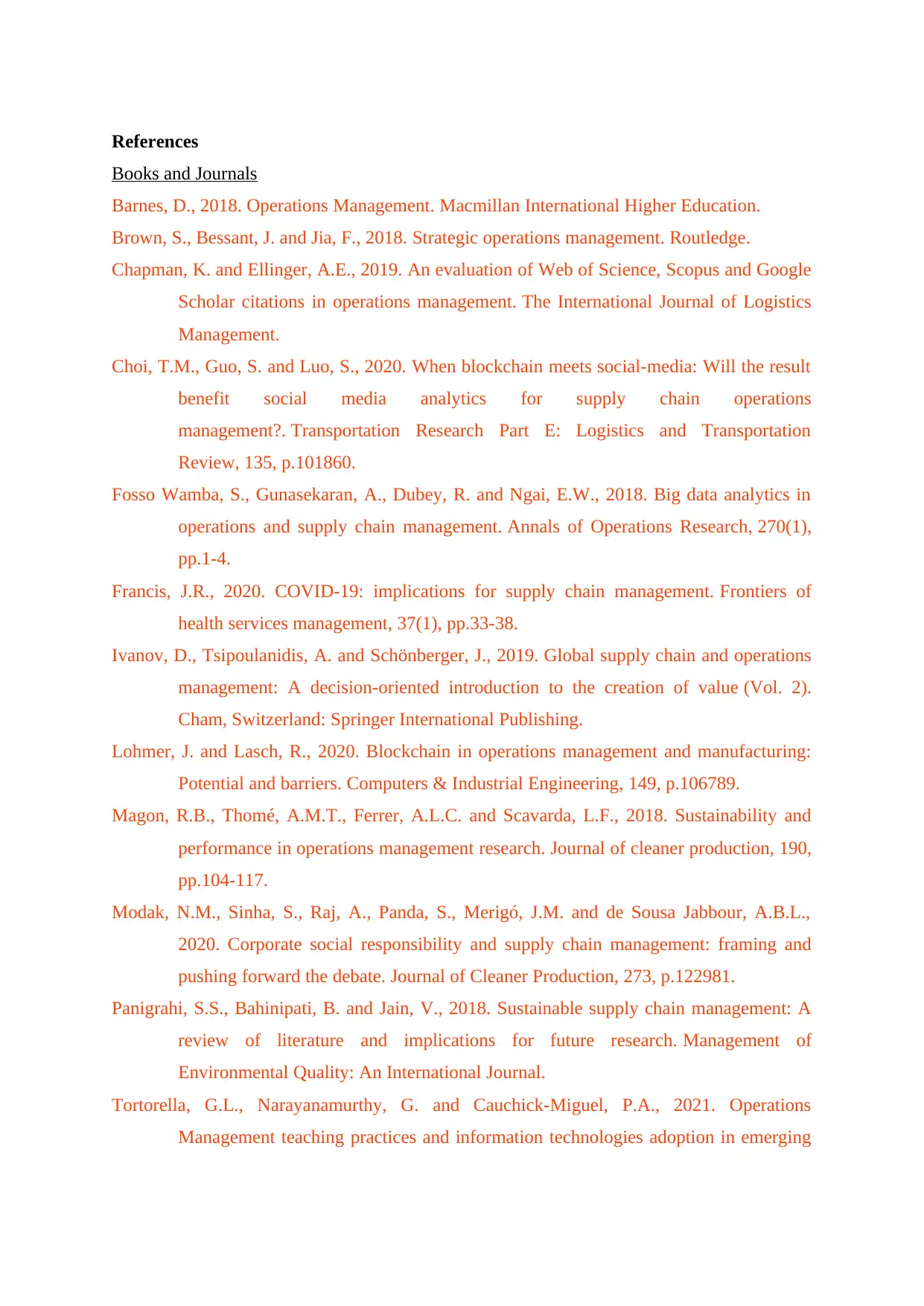
References
Books and Journals
Barnes, D., 2018. Operations Management. Macmillan International Higher Education.
Brown, S., Bessant, J. and Jia, F., 2018. Strategic operations management. Routledge.
Chapman, K. and Ellinger, A.E., 2019. An evaluation of Web of Science, Scopus and Google
Scholar citations in operations management. The International Journal of Logistics
Management.
Choi, T.M., Guo, S. and Luo, S., 2020. When blockchain meets social-media: Will the result
benefit social media analytics for supply chain operations
management?. Transportation Research Part E: Logistics and Transportation
Review, 135, p.101860.
Fosso Wamba, S., Gunasekaran, A., Dubey, R. and Ngai, E.W., 2018. Big data analytics in
operations and supply chain management. Annals of Operations Research, 270(1),
pp.1-4.
Francis, J.R., 2020. COVID-19: implications for supply chain management. Frontiers of
health services management, 37(1), pp.33-38.
Ivanov, D., Tsipoulanidis, A. and Schönberger, J., 2019. Global supply chain and operations
management: A decision-oriented introduction to the creation of value (Vol. 2).
Cham, Switzerland: Springer International Publishing.
Lohmer, J. and Lasch, R., 2020. Blockchain in operations management and manufacturing:
Potential and barriers. Computers & Industrial Engineering, 149, p.106789.
Magon, R.B., Thomé, A.M.T., Ferrer, A.L.C. and Scavarda, L.F., 2018. Sustainability and
performance in operations management research. Journal of cleaner production, 190,
pp.104-117.
Modak, N.M., Sinha, S., Raj, A., Panda, S., Merigó, J.M. and de Sousa Jabbour, A.B.L.,
2020. Corporate social responsibility and supply chain management: framing and
pushing forward the debate. Journal of Cleaner Production, 273, p.122981.
Panigrahi, S.S., Bahinipati, B. and Jain, V., 2018. Sustainable supply chain management: A
review of literature and implications for future research. Management of
Environmental Quality: An International Journal.
Tortorella, G.L., Narayanamurthy, G. and Cauchick-Miguel, P.A., 2021. Operations
Management teaching practices and information technologies adoption in emerging
Books and Journals
Barnes, D., 2018. Operations Management. Macmillan International Higher Education.
Brown, S., Bessant, J. and Jia, F., 2018. Strategic operations management. Routledge.
Chapman, K. and Ellinger, A.E., 2019. An evaluation of Web of Science, Scopus and Google
Scholar citations in operations management. The International Journal of Logistics
Management.
Choi, T.M., Guo, S. and Luo, S., 2020. When blockchain meets social-media: Will the result
benefit social media analytics for supply chain operations
management?. Transportation Research Part E: Logistics and Transportation
Review, 135, p.101860.
Fosso Wamba, S., Gunasekaran, A., Dubey, R. and Ngai, E.W., 2018. Big data analytics in
operations and supply chain management. Annals of Operations Research, 270(1),
pp.1-4.
Francis, J.R., 2020. COVID-19: implications for supply chain management. Frontiers of
health services management, 37(1), pp.33-38.
Ivanov, D., Tsipoulanidis, A. and Schönberger, J., 2019. Global supply chain and operations
management: A decision-oriented introduction to the creation of value (Vol. 2).
Cham, Switzerland: Springer International Publishing.
Lohmer, J. and Lasch, R., 2020. Blockchain in operations management and manufacturing:
Potential and barriers. Computers & Industrial Engineering, 149, p.106789.
Magon, R.B., Thomé, A.M.T., Ferrer, A.L.C. and Scavarda, L.F., 2018. Sustainability and
performance in operations management research. Journal of cleaner production, 190,
pp.104-117.
Modak, N.M., Sinha, S., Raj, A., Panda, S., Merigó, J.M. and de Sousa Jabbour, A.B.L.,
2020. Corporate social responsibility and supply chain management: framing and
pushing forward the debate. Journal of Cleaner Production, 273, p.122981.
Panigrahi, S.S., Bahinipati, B. and Jain, V., 2018. Sustainable supply chain management: A
review of literature and implications for future research. Management of
Environmental Quality: An International Journal.
Tortorella, G.L., Narayanamurthy, G. and Cauchick-Miguel, P.A., 2021. Operations
Management teaching practices and information technologies adoption in emerging

economies during COVID-19 outbreak. Technological Forecasting and Social
Change, 171, p.120996.
Waleczek, P., von den Driesch, T., Flatten, T.C. and Brettel, M., 2019. On the dynamic
bundles behind operations management and research and development. European
Management Journal, 37(2), pp.175-187.
Change, 171, p.120996.
Waleczek, P., von den Driesch, T., Flatten, T.C. and Brettel, M., 2019. On the dynamic
bundles behind operations management and research and development. European
Management Journal, 37(2), pp.175-187.
1 out of 9
Related Documents
Your All-in-One AI-Powered Toolkit for Academic Success.
+13062052269
info@desklib.com
Available 24*7 on WhatsApp / Email
![[object Object]](/_next/static/media/star-bottom.7253800d.svg)
Unlock your academic potential
© 2024 | Zucol Services PVT LTD | All rights reserved.





